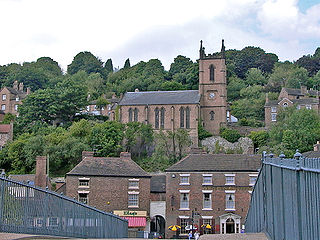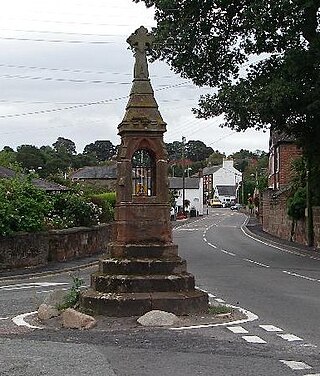
Ironbridge is a large village in the borough of Telford and Wrekin in Shropshire, England. Located on the bank of the River Severn, at the heart of the Ironbridge Gorge, it lies in the civil parish of The Gorge. Ironbridge developed beside, and takes its name from, The Iron Bridge, a 100-foot (30 m) cast iron bridge that was built in 1779.

Ruyton-XI-Towns, formally Ruyton of the Eleven Towns or simply Ruyton, is a village and civil parish next to the River Perry in Shropshire, England. It had a population of 1,379 at the 2011 Census.

Clun is a town in south west Shropshire, England, and the Shropshire Hills Area of Outstanding Natural Beauty. The 2011 census recorded 680 people living in the town. Research by the Campaign for the Protection of Rural England suggests that Clun is one of the most tranquil locations in England.

Atcham is a village, ecclesiastical parish and civil parish in Shropshire, England. It lies on the B4380, 5 miles south-east of Shrewsbury. The River Severn flows round the village. To the south is the village of Cross Houses and to the north-west the hamlet of Emstrey.

Cleobury Mortimer is a market town and civil parish in south-east Shropshire, England, which had a population of 3,036 at the 2011 census. It was granted a market charter by King Henry III in 1226.

William Charles Williams VC was a British recipient of the Victoria Cross, the highest and most prestigious award for gallantry in the face of the enemy that can be awarded to British and Commonwealth forces.

Condover is a village and civil parish in Shropshire, England. It is about 5 miles (8 km) south of the county town of Shrewsbury, and just east of the A49. The Cound Brook flows through the village on its way from the Stretton Hills to a confluence with the River Severn. Condover is near to the villages of Dorrington, Bayston Hill and Berrington. The population of the Condover parish was estimated as 1,972 for 2008, of which an estimated 659 live in the village of Condover itself. The actual population measured at the 2011 census had fallen to 1,957.

Stokesay is a village and former civil parish, now in the parish of Craven Arms, in the Shropshire district, in the ceremonial county of Shropshire, England. It is just south of Craven Arms on the A49 road, also fleetingly visible from the Shrewsbury to Hereford Welsh Marches railway line. In 1961 the parish had a population of 1217.

Pitchford is a small village in the English county of Shropshire. It is located between Cantlop and Acton Burnell and stands on an affluent of the River Severn. Pitchford takes its name from a bituminous spring/pitch in the village, located near The Row Brook.

Whixall is, by land area, the third largest inland village in England and a civil parish in Shropshire, England. It is documented in the Domesday Book as having been in existence in 1086.

Kinlet is a small village and civil parish in the south-east of the county of Shropshire, England. The parish is on the northern edge of the Wyre Forest and is in the Bridgnorth District of Shropshire. The parish incorporates the hamlets of Kinlet Village, Button Bridge and Button Oak. Kinlet is located 18 miles (29 km) south of Telford, the main town in Shropshire and 23 miles (37 km) west of Birmingham.

Worfield is a village and civil parish in Shropshire in the West Midlands, England. It is 120 miles (190 km) northwest of London and 10 miles (16 km) west of Wolverhampton. It is north of Bridgnorth and southeast of Telford. The parish, which includes the hamlet of Chesterton, is an extensive one which lies on the River Worfe. The name Worfield comes from its location on the river Worfe and the surrounding countryside (fields).

Selattyn is a village and former civil parish, now in the parish of Selattyn and Gobowen, in the Shropshire district, in the ceremonial county of Shropshire, England. It is on the England–Wales border, close to Oswestry. In 1961 the parish had a population of 1830. On 1 April 1967 the parish was abolished to form "Selattyn and Gobowen", part also went to Whittington.

Major General Thomas Savage, 3rd Earl Rivers was an English nobleman and soldier.

Neen Sollars is a village and civil parish in south east Shropshire, England.

Neenton is a civil parish and small village in south east Shropshire, England, which is situated on the B4364 southwest of the market town of Bridgnorth. The Rea Brook/River Rea, which was historically known as the River Neen, flows by the village. There is a church on the corner of the B4364 passing through Neenton called the All Saints Church, also there is a public house open, called the Pheasant Inn.
Neen Savage is a civil parish in Shropshire, England. It contains 17 listed buildings that are recorded in the National Heritage List for England. Of these, two are at Grade II*, the middle of the three grades, and the others are at Grade II, the lowest grade. The parish contains the village of Neen Savage and the surrounding countryside. The oldest listed building is the church, which originated in the 12th century. Most of the other listed buildings are houses, cottages, farm houses and farm buildings, the earliest of which are timber framed. The other listed buildings are a vicarage and a war memorial.
Neen Sollars is a civil parish in Shropshire, England. It contains 17 listed buildings that are recorded in the National Heritage List for England. Of these, one is at Grade II*, the middle of the three grades, and the others are at Grade II, the lowest grade. The parish contains the village of Neen Sollars and the surrounding countryside. Most of the listed buildings are in or near the village, and these consist of a church and memorials in the churchyard, and houses, cottages and farmhouses, many of which are timber framed. To the south of the parish are three more listed buildings, one a house, and the other two that were formerly associated with the Leominster Canal, an aqueduct and the original headquarters of the canal company.



















